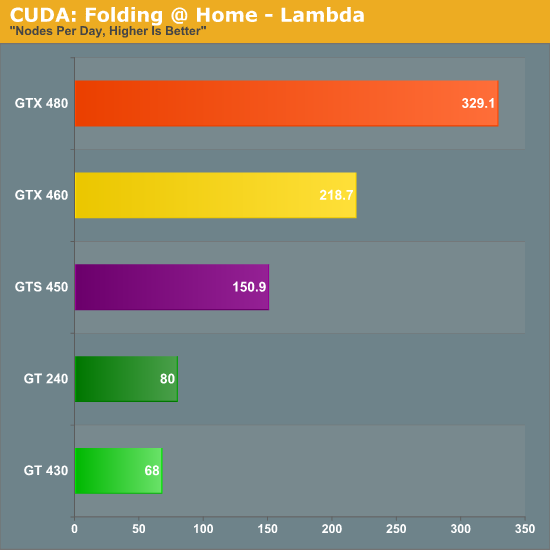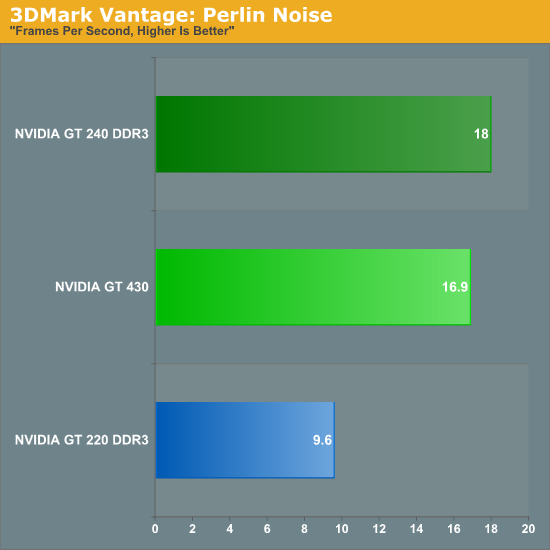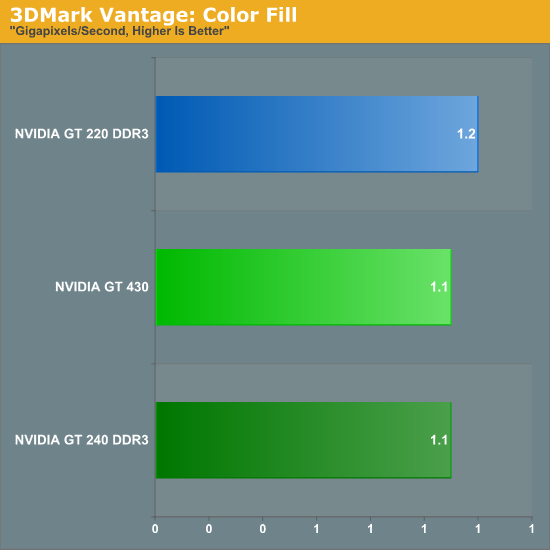NVIDIA's GeForce GT 430: The Next HTPC King?
by Ryan Smith & Ganesh T S on October 11, 2010 9:00 AM ESTCompute Performance & Synthetics
While the GT 430 isn’t meant to be a computing monster and you won’t see NVIDIA presenting it as such, it’s still a member of the Fermi family and possesses the family’s compute capabilities. This includes the Fermi cache structure, along with the 48 CUDA core SM that was introduced with GF104/GTX 460. This also means that it has a greater variation of performance than the past-generation NVIDIA cards; the need to extract ILP means the card performs between a 64 CUDA core card and a 96 CUDA core card depending on the application.
Meanwhile being based on the GF104 SM, the GT 430 is FP64 capable at 1/12th FP32 speeds (~20 GFLOPS FP64), a first for a card of this class.
For our look at compute performance we’ll turn to our trusty benchmark copy of Folding @ Home. We’ve also included the GT 240, a last-generation 96 CUDA core card just like the GT 430. This affords us an interesting opportunity to see the performance of Fermi compared to GT200 with the same number of CUDA cores in play, although GT 430 has a clockspeed advantage here that gives it a higher level of performance in theory.

The results are interesting, but also a bit distressing. GT 430’s performance as compared to the GTS 450’s performance is quite a bit lower, but this is expected. GT 240 however manages to pull ahead by nearly 17%, which is quite likely a manifestation of Fermi’s more variable performance. This makes the GT 220 comparison all the more appropriate, as if Fermi’s CUDA cores are weaker on average then GT 430 can’t hope to keep pace with GT 240.
To take a second look at CUDA core performance, we’ve also busted 3DMark Vantage out of the vault. As we’ve mentioned before we’re not huge fans of synthetic tests like 3DMark since they encourage non-useful driver optimizations for the benchmark instead of real games, but the purely synthetic tests do serve a useful purpose when trying to get to the bottom of certain performance situations.
We’ll start with the Perlin Noise test, which is supposed to be computationally bound, similar to Folding @ Home.

Once more we see the GT 430 come in behind the GT 240, even though the GT 430 has the theoretical advantage due to clockspeed. The loss isn’t nearly as great as it was under Folding @ Home, but this lends more credit to the theory that Fermi shaders are less efficient than GT21x CUDA cores. As a card for development GT 430 still has a number of advantages such as the aforementioned FP64 support and C++ support in CUDA, but if we were trying to use it as a workhorse card it looks like it wouldn’t be able to keep up with GT 240. Based on our gaming results earlier, this would seem to carry over to shader-bound games, too.
Moving on, we also used this opportunity to look at 3DMark Vantage’s color fill test, which is a ROP-bound test. With only 4 ROPs on the GT 430, this is the perfect synthetic test for seeing if having fewer ROPs really is an issue when we’re comparing GT 430 to older cards.

And the final verdict? A not very useful yes and no. GT 220 and GT 240 both have 8 ROPs, with GT 220 having the clockspeed advantage. This is why GT 220 ends up coming out ahead of GT 240 here by less than 100 MPixels/sec. But on the other hand, GT 430 has a clockspeed advantage of its own while possessing half the ROPs. The end result is that GT 430 is effectively tied with these previous-generation cards, which is actually quite a remarkable feat for having half the ROPs.
NVIDIA worked on making the Fermi ROPs more efficient and it has paid off by letting them use 4 ROPs to do what took 8 in the last generation. With this data in hand, NVIDIA’s position that 4 ROPs is enough is much more defensible, as they’re at least delivering last-generation ROP performance on a die not much larger than GT216 (GT 220). This doesn’t provide enough additional data to clarify whether the ROPs alone are the biggest culprit in the GT 430’s poor gaming performance, but it does mean that we can’t rule out less efficient shaders either.
Do note however that while Fermi ROPs are more efficient than GT21x ROPs, it’s only a saving grace when doing comparisons to past-generation architectures. GT 430 still only has ¼ the ROP power as GTS 450, which definitely hurts the card compared to its more expensive sibling.










120 Comments
View All Comments
geok1ng - Tuesday, October 12, 2010 - link
The other consumer grade low cost Blu-Ray Player is the PS3. It qould be nice to have baseline HQV2 numbers for the last firmware of PS3 , so that readers could get a measure of how much picture quality, if any, a HTPC has over a PS3.As for the 3D HTPC card, i simply do not see the owner of a 3D TV using such a low end card. The minimum budget wise is a 768MB 460.
Now NVIDIA should work for a passive card that can beat the 5750 on picture quality, until then it is a PS3 for 3D Bluray and a 5750 for HTPC.
Arnejoh - Tuesday, October 12, 2010 - link
Some of us in here likes to see how new and old Nvidia cards is doing as dedicated Physx cards. There is some tests out there like fluidmark. And i know this is no problem for experts like you @Anandtech :)Hrel - Tuesday, October 12, 2010 - link
Looks like the only card I'd buy for the low end is the HD5670. Slowest card you can buy that allows acceptable gaming and it's a great HTPC card. You can easily find fully silent versions.manokius - Wednesday, October 13, 2010 - link
It's quite simple:an HTPC Must Be Quiet!Power consumption is a factor but most of all you need tranquility when watching movies etc.
So, you need a FANLESS card for not adding noise to the system apart from what the CPU and PSU emits.
What is this then and why is the author giving it the title "HTPC King"?
krumme - Wednesday, October 13, 2010 - link
"The next HTPC King?"Well and the answer to that was pretty much a weak no in my reading.
We have dirt cheap ontario hdmi 1.4, 3d comming with a cpu+gpu for less than this card. This is unfortunately 2 years to late.
dragonsqrrl - Wednesday, October 13, 2010 - link
"unlike all of NVIDIA’s other desktop launches which had GPUs with disabled functional units, the GT 430 uses a fully enabled GF108 GPU. For once with Fermi, we’ll be able to look at the complete capabilities of the GPU."I believe the GTS450 incorporated a fully activated gf106 with 192 SP's, did it not?
Ryan Smith - Thursday, October 14, 2010 - link
All of its SPs, but only 2/3rds of its ROPs and memory controllers.BoonDoggie - Thursday, October 14, 2010 - link
How can any card that cant do decent gaming @ 1920x1080 be called an HTPC card? What a douchebag title. HTPC video cards have to be:A) Able to do video decoding.
B) Do gaming at the defacto standard of 1920x1080.
C) Do it quietly.
NO HTPC card should even be considered unless it can do these. Yes you can get by without gaming, but, since an HTPC can do gaming and console type gaming is regularly seen on the main TV at home, I think it should be a needed quantifier of a decent HTPC card.
Radeth - Monday, November 1, 2010 - link
Hi!I'd like to build an HTPC and I got some questions..These are the specs:
MB: Zotac H55-ITX-A-E
CPU: I3 530 2,92 GHz
RAM: 4Gb DDR3 Kingston SO-DIMM
Optical: LG slim DVD writer
HD: WD Caviar Green Power 500 Gb 3,5"
GPU: Undecided between HD5570 and GT430 or other
What would be the best card to use (even one i didn't mention like GT220) with a 120W power source mini-ITX case?
Thank you
MavAnan - Saturday, November 13, 2010 - link
The review says: "For now, the Radeon HD 5570 is a clear winner from the picture quality standpoint."Does the 5570 also beat the GT240 from the picture quality standpoint?